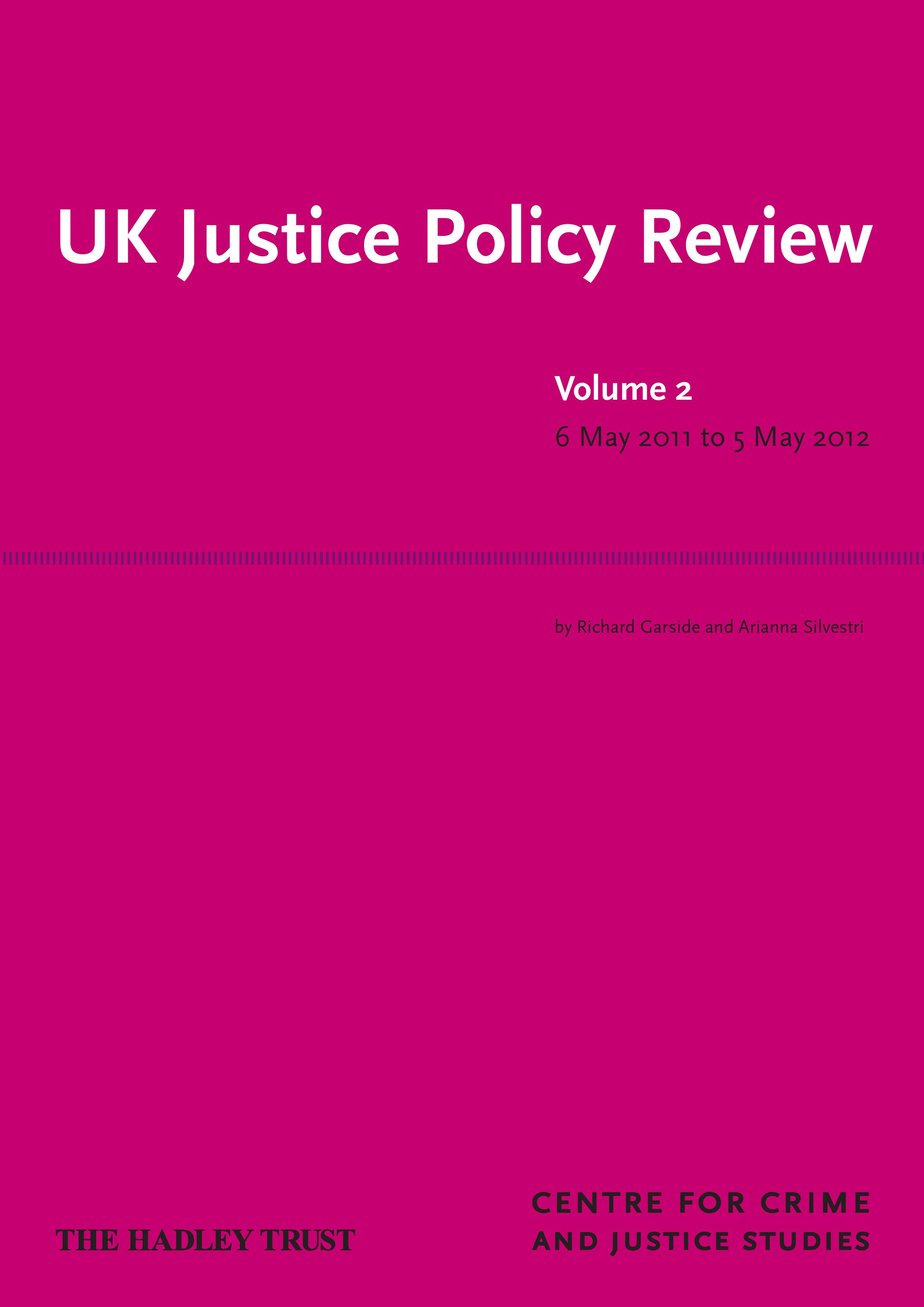The second in an annual series by the Centre for Crime and Justice Studies, supported by the Hadley Trust, tracking year-on-year developments in criminal justice and social welfare across the UK.
Combining analysis of the main developments with key data on issues such as spending, staffing and the numbers going through the criminal justice system, UK Justice Policy Review offers an accessible overview of UK-wide developments.
This issue finds that spending on law and order in the UK fell by ten per cent in the first two years of coalition government, a new report published by the Centre for Crime and Justice Studies today reveals. While the UK was spending £36 bn in real terms on public order and safety in 2009/10, before the coalition government came to power, by 2011/2012 this had fallen to £32.3 bn. In comparison the total UK public sector spend on services fell by 1.4 per cent in the same period.
The report also finds that the spending squeeze set by Westminster was applied differently in different jurisdictions. In England and Wales central government expenditure on criminal justice fell in real terms by 12 per cent between 2009/2010 and 2011/2012. In Scotland it increased by four per cent in the same period.
The number of police officers declined by seven per cent in England and Wales and by nine per cent in Northern Ireland in the first two years of the Coalition, while in Scotland they remained largely unaltered. The numbers of prison staff decreased in England and Wales and Northern Ireland, by 11 per cent and 17 per cent respectively. In Scotland the numbers rose by three per cent.
UK Justice Policy Review is the second in an annual series by the Centre for Crime and Justice Studies that tracks year-on-year developments in criminal justice and social welfare across the UK. This second edition concentrates on the period May 2011 to April 2012 and includes:
- An overview of policing, courts and legal aid, prisons and probation, and welfare reform during the coalition's second year in power.
- Data sections covering who got processed by the criminal justice system following the English riots, criminal justice expenditure, criminal justice staffing, numbers processed by the criminal justice system and trends in social need.
The report shows that most of the people the police arrested after the riots in the streets of England in the summer of 2011 were people the police already knew. They were predominantly young and disproportionately black or from other minority ethnic groups. They were sent to prison for periods of time which were 24% longer than for comparable offences committed at other times. 66% of the suspected rioters aged 10-17 who were brought before the courts had special educational needs. Thirty of the areas affected by the riots were in the top 25% most deprived areas in England.
UK Justice Policy Review also reveals that the coalition paid five major contractors over £440m for public order services between May 2011 and April 2012. The government's `transparency data' (which only covers expenditure over £25,000) shows the payments that the Ministry of Justice made in that period:
- The biggest recipient among the five was ATOS, who were paid £151m, mainly for IT support supplied to the Ministry of Justice, NOMS and the Courts and Tribunals Service.
- Serco provided prisoner escorting, as well as electronic monitoring, resettlement services and the running of HMP Doncaster, receiving £113m that year.
- Geo Amey received £54m for electronic monitoring and prisoner escorting; A4E £5m for resettlement work and payments and support services; G4S were paid £118m for operating HMP Wolds, HMP Birmingham and for running prisoner custody and escort services.
Other key facts and figures from the second edition include:
- Although recorded crime fell by 3.4 in 2011/2012 compared to the previous year, the number of people in prison in the UK continued to rise and is projected to go over 100,000 by 2018, according to one scenario.
- Over two million people in the UK continue to be convicted of an offence by the courts or are subject to an out-of-court sanction such as a fixed penalty notice. On the other hand, the numbers of people ordered to pay a fine or to serve a sentence in the community have continued to decline overall since a peak in 2007.
Richard Garside, Director of the Centre for Crime and Justice Studies and co-author of the report said:
After several years of plenty for the criminal justice system under Labour, the coalition is intent on delivering several years of relative famine. Yet across the four UK nations the picture is mixed: contraction in England, Wales and Northern Ireland; continued growth in Scotland.
The coalition's second year was a period of major conflict with the police rank and file; u-turns on sentencing reform; riots in the streets and division within the government. Reform and good governance proved much harder in an era of austerity than in the previous period of relative plenty.
Arianna Silvestri, Policy and Research Associate at the Centre for Crime and Justice Studies and co-author of the report said:
The UK Justice Policy Review aims at making publicly accessible information that would otherwise be difficult to obtain or to easily digest. This year we have continued to gather this from various sources and Freedom of Information requests, as well as mining the government's 'transparency data', which is published in raw - and very difficult to analyse - form. Information we have extracted about outsourced prisoner escorting services will be of particular interest in the light of recent exposure of some of the main contractors' practices and the Inspectorate of Prisons' concerns about such services in their latest annual report.
